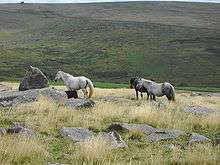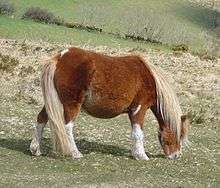Dartmoor pony
|
Dartmoor pony | |
| Country of origin | England |
|---|---|
| Traits | |
| Distinguishing features | Small but strong, many colours, hardy |
The Dartmoor pony is one of the horse breeds that have lived on Dartmoor England for centuries and is used for a variety of disciplines. Because of the extreme weather conditions experienced on the moors, the Dartmoor is a particularly hardy breed with excellent stamina. Over the centuries it has been used as a working animal by local tin miners and quarry workers. It is kept in a semi-feral state on Dartmoor.
Despite this, numbers living on the open moor have declined from an estimated 5000 in 1900 to about 300 registered ponies today. Only around 800 ponies were known to be grazing the moor in the spring of 2004.[1]
Breed characteristics
The small head has large, wide-set eyes and alert ears. The body is strong, with a broad, deep rib cage, and of medium length. The legs are strong, long from body to knee and hock, but with short cannons with strong, dense bone, and a flat-fronted knee; the foreleg rises to a shoulder that is well-angled and with good freedom of movement, and the hindleg rises to a quarter that is well-muscled and rounded in appearance, rather than flat or sloping. The mane and tail should be full and flowing, and the pony's movement free and smooth. The Dartmoor pony has a kind temperament, the ponies being reliable, gentle and calm. Most Dartmoor ponies stand between 11.1 to 12.2 hands (45 to 50 inches, 114 to 127 cm); a pony should stand at no more than 12.2 hands under the breed standard, introduced in 1924. Recognised colours include bay, brown, black, grey, chestnut or roan.[2]
Piebald and skewbald colouring is not permitted within the Dartmoor Pony breed. Ponies with this colouring, seen running on Dartmoor, are likely to be Dartmoor Hill Ponies as Dartmoor commoners may graze any type of pony out on the moors.[3] The Dartmoor Hill Pony is classified as a pony born on Dartmoor, but not a purebred registered Dartmoor Pony. It is not a true breed as such, as the registry for Dartmoor Hill Ponies is open only to those born on the moors, so a pony born of two Dartmoor Hill ponies, but not born on the moors, could not be registered with the Dartmoor Hill Pony Association.[4]
Although Exmoor ponies live fairly close geographically and their markings are somewhat similar, evidence now suggests that Dartmoor ponies and Exmoor ponies are not related as was once thought.
History
The bones of prehistoric horses have been found in chamber tombs dating from Vere Gordon Childe's period III - IV in southern Britain. This would date the bones at the transition from a hunter-gatherer society to an agricultural society (the Neolithic Revolution) at around 3500 BC; the bones are probably from wild horses but domestication may have begun by that date.[5] Archeological investigation from the 1970s has shown that domesticated ponies were to be found on Dartmoor as early as 1500 BC.[6] The first written record, dated to AD 1012, refers to wild horses at Ashburton, and early records from Dartmoor manors refer to ponies being branded and ear-marked.[7]

The Dartmoor Pony was used in medieval times for carrying heavy loads of tin from the mines across the moor.[8] When the mines closed, some ponies were kept for farming, but most of the ponies were turned out onto the moor. Ponies were bred at Dartmoor Prison from the early 1900s up until the 1960s, and used by guards for escorting prisoners.[9]
The Dartmoor received Arab blood from the stallion Dwarka, foaled in 1922, as well as Dwarka’s son, The Leat.[8] Welsh pony breeding was introduced from the stallion Dinarth Spark, and infusions of Fell Pony blood was also added.[10]

The first attempt to define and register the breed was in 1898, when the ponies were entered into a studbook started by the Polo Pony Society. In 1924, the breed society was founded, and a studbook opened.[8] World War I and World War II were devastating to the breed. Only a handful of ponies were registered during World War II. However, after the war, local people began to inspect and register as many ponies as they could, and by the 1950s, numbers were back up.
Two schemes have been introduced to halt the decline in numbers, and broaden the gene pool of the Dartmoor Pony. The Dartmoor Pony Moorland Scheme (DPMS) was established in 1988 and is administered by the Dartmoor Pony Society and the Duchy of Cornwall, as well as being supported by the Dartmoor National Park. In 2004 a new scheme, the Dartmoor Pony Preservation Scheme (DPPS), was introduced, and herds taking part in this new scheme must enter one mare each year to the DPMS. The Dartmoor Pony has been granted Rare Breed status.[11]
Dartmoor Ponies today

Dartmoor ponies are native to Britain, but are also seen in other parts of the world including the USA,[12] Continental Europe, New Zealand and Australia.[13] They are often used as foundation breeding stock for the Riding Pony.[14] The breed is a suitable size and temperament for a children’s mount, but it is also quite capable of carrying an adult. They are used for hunting, trail riding,[15] showing,[16] jumping, dressage and driving,[17] as well as everyday riding.
All ponies free-roaming on Dartmoor are owned and protected by Dartmoor Commoners. It is illegal for visitors to feed the ponies although it is a common sight to see ponies being fed snacks through an open car window.[18]
See also
Notes
- ↑ BBC News, April 2004
- ↑ "About The Breed". Dartmoor Pony Society. Retrieved 21 February 2011.
- ↑ Dartmoor Commoners Council
- ↑ Ponies found on Dartmoor, The Dartmoor Hill Pony Association
- ↑ Daniel 1950, p. 173
- ↑ National Park Information Leaflet
- ↑ Local Government Factsheet
- 1 2 3 Dent 2007, p. 152
- ↑ Lynghaug 2009, p. 464
- ↑ The British Horse
- ↑ Dartmoor Pony Heritage Trust
- ↑ Dartmoor Pony Registry of America
- ↑ Dartmoor Societies in Europe and Australia
- ↑ Rayner 1974, p. 181
- ↑ Lynghaug 2009, p. 462
- ↑ Horse of the Year Show Champion Dartmoor
- ↑ Dartmoors in Competition
- ↑ National Park Authority, Byelaws and Information
References
- Dent, Anthony Austen; Hendricks, Bonnie L. (2007), International Encyclopedia of Horse Breeds, Norman: University of Oklahoma Press, ISBN 0-8061-3884-X
- Lynghaug, Fran (2009), The Official Horse Breeds Standards Guide: The Complete Guide to the Standards of All North American Equine Breed Associations, Stillwater, MN: Voyageur Press, ISBN 0-7603-3499-4
- Rayner, Judy (1974), The horseman's companion: a guide to riding and horses, London: Croom Helm, p. 181, ISBN 0-85664-200-2
- Daniel, Glynn (1950), The Prehistoric Chamber Tombs of England and Wales, Cambridge University Press, ASIN B0000CHRBZ
External links
| Wikimedia Commons has media related to Free roaming ponies in Dartmoor. |